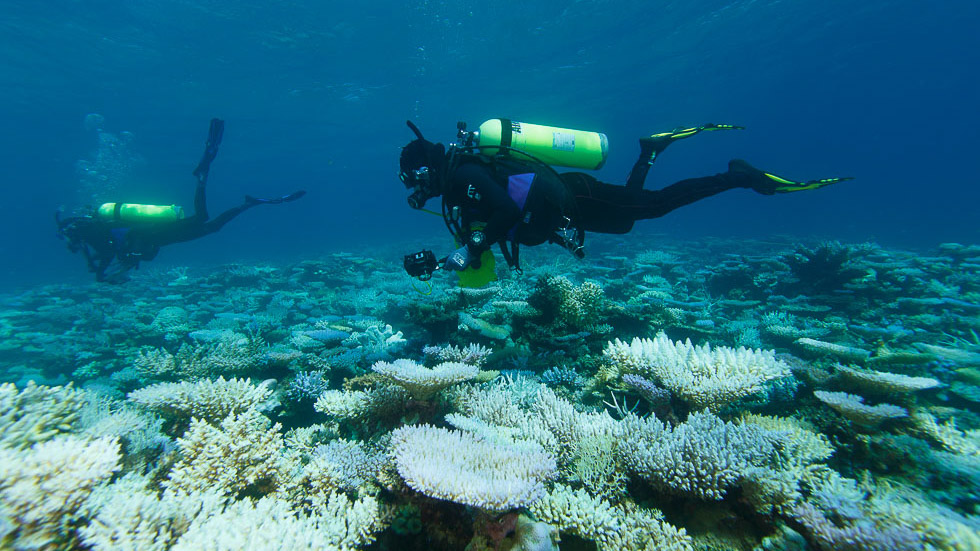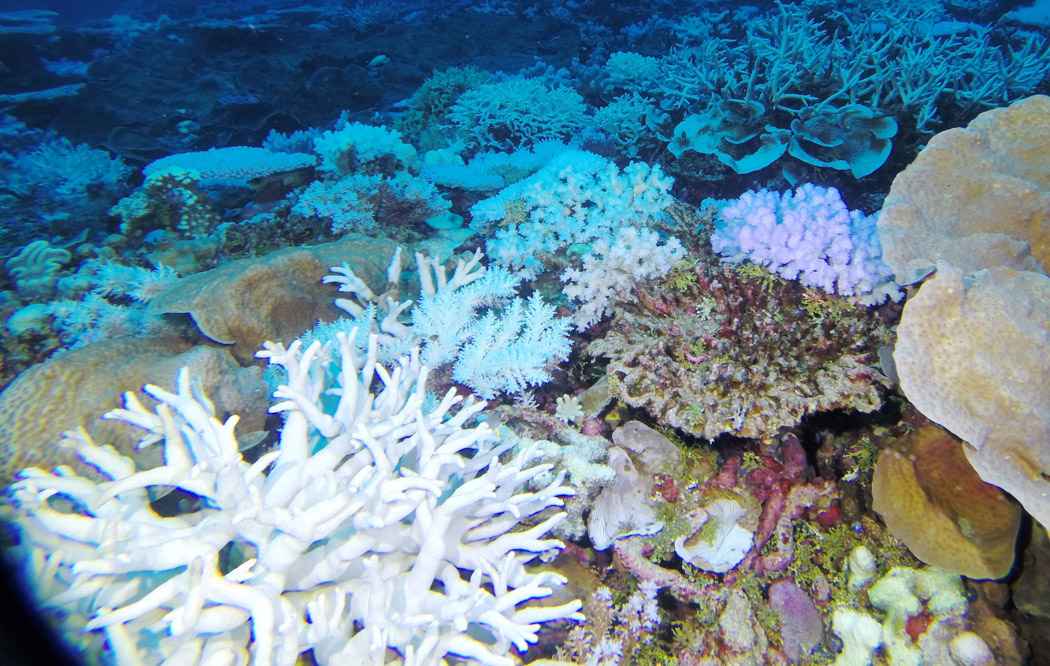AIMS diver assess coral bleaching at Scott Reef in April 2016 (Image: Nick Thake)
AIMS researchers are collating their data after a two week coral bleaching monitoring voyage to several oceanic coral reefs on the northwest Australian continental shelf.
The research team, led by Dr James Gilmour, visited Scott Reef, Seringapatam Reef and the Rowley Shoals (see map in image gallery) aboard AIMS’ RV Solander. Divers discovered severe widespread bleaching at Scott and Seringapatam Reefs. In contrast, little bleaching was observed at the Rowley Shoals.
Over the past 2 months unusually warm sea surface temperatures have affected many coral reef communities in the northwest region of Australia to varying degrees including the Kimberley, Christmas Island and a number of reefs and shoals between Darwin and Broome. There have been no reports of major coral bleaching on reefs in the Pilbara, Ningaloo or further south to date.
Researchers from multiple research and management institutions across Western Australia have collaborated in documenting the distribution and severity of the bleaching event through both aerial and in-water surveys. This information is currently being collated and interpreted to provide a broad picture of the impact of bleaching on the State’s coral reef communities.
For more information on the preparations for the bleaching in Western Australia, and further details on AIMS’ bleaching research in the region, click here.
Key findings
Scott Reef
The team found that ‘extreme’ bleaching (between 60 - 90% of the community affected) had occurred in the shallow coral communities across Scott Reef. Researchers also discovered that a large amount of coral loss had already occurred at the time of their surveys. At some sites, loss of coral cover had already reached 50%.
This high level of bleaching was not restricted to the shallow reef flat (3m) and reef slope (6m) surveys, but was also observed in the normally cooler, deeper waters around 20m and beyond. Camera surveys of communities in 40m in the deep Scott Reef lagoon revealed ‘major’ bleaching at approximately 50%. The temperature at this depth was 30.5°C. During the last widespread, severe bleaching at Scott Reef in 1998, these coral communities did not bleach.
Significant bleaching was observed at depths beyond 20m within the Scott Reef lagoon. Researchers were unable to carry out diver-based surveys at this depth, so dropcams were used to assess bleaching levels.
Bleaching severity increased during the monitoring trip to Scott Reef. Repeated observations at the over the course of a week revealed an increase in bleaching severity from ‘moderate’ to ‘severe’ at some sites.
Seringapatam Reef
Bleaching was widespread and severe at Seringapatam Reef. 60-90% of the coral community of the outer slopes and inside the lagoon were bleached (‘extreme’ category). Some coral types, such as massive Porites and Echinopora species, were less affected with approximately half their population bleaching. Observations of coral communities at 30m via camera feed indicated they were also severely bleached.
Rowley Shoals
Coral communities in the shallow reef flat areas showed minor (<10%) bleaching.
Water temperatures at these reefs were cooler (31°C – 29°C) compared to Scott Reef and Seringapatam Reef (water temperatures of approximately 33°C and 32°C respectively). This difference, combined with more windy and overcast local conditions, may have contributed to the reduced incidence of bleaching in the area.
Future research
Data on coral bleaching in Western Australia was collected by multiple research and management organisations. This state-wide information on this year’s bleaching event is currently being collated and analysed to understand the full extent of the bleaching. In particular, the analysis will specifically examine how different climatic and oceanographic conditions over the last ten years have caused the contrasting patterns of bleaching in regions across Western Australia.
AIMS researchers will return to the northwest reefs in October this year to record coral loss and determine the survivorship of the coral communities.
For further information on the 2016 coral bleaching event in Western Australia:
05 April: Western Australian reefs feel the heat from global bleaching event
Image Gallery
Click images to open



